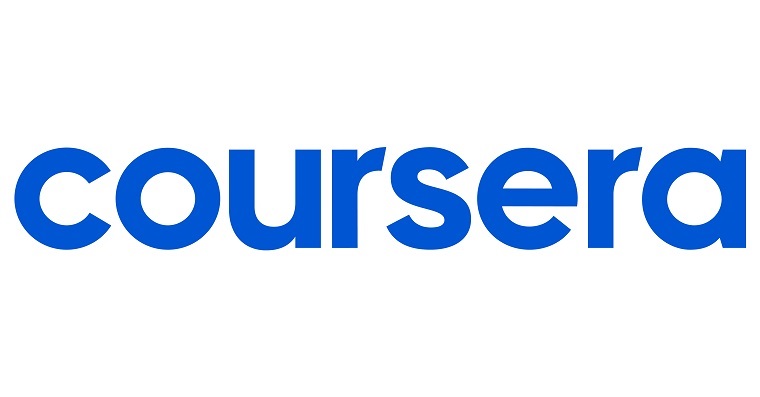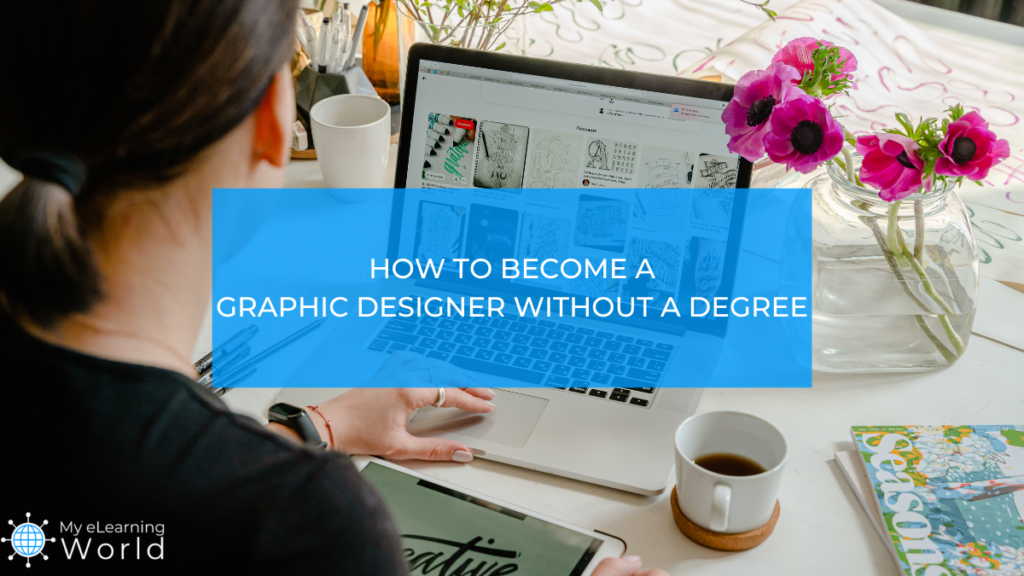Are you looking for clear guidance that will show you exactly how to become a graphic designer without a degree?
Graphic design is a thriving field with plenty of career opportunities for talented individuals. The industry has continued to grow steadily over the years, offering more and more opportunities for creative professionals.
Whether you want to work for a company as an in-house designer, become a freelancer, or even start your own small design agency, there are tons of different ways you can make money as a graphic designer.
You may be thinking that you need to get a degree in graphic design first. However, you’ll be happy to know that this isn’t the case.
While a degree can give you a strong foundation and technical skillset, it’s not always necessary to have one to succeed in this field. In fact, the latest data shows that about one-third of all graphic designers don’t have any kind of bachelor’s degree, meaning there are plenty of opportunities to get into graphic design without a degree.
With online learning options from sites like Skillshare and LinkedIn Learning, you can get the training you need to become a graphic designer without going to college.
Here’s what you need to know about how to become a graphic designer without a degree.
Disclosure: Some of the links in this article are affiliate links, meaning at no additional cost for you, we might get a commission if you click the link and purchase.
What is a Graphic Designer?
A graphic designer is responsible for the visual style and images in magazines, newspapers, product packaging, and websites. They use color, type, illustration, photography, animation, and various printing and layout techniques to create a unifying style and message for their client or company.
Graphic designers work with both text and images. They often select the typeface, font size, line length, leading (line spacing), kerning (spacing between letters), and other elements of typography to create legible, readable, and appealing text.
In addition to selecting and arranging typefaces, graphic designers also decide how images will appear next to text and on what page(s) they will be included.
Graphic designers must also communicate effectively with clients, salespeople, and other designers to make sure their work matches the needs and expectations set forth for the project.
What Skills Do You Need to Become a Graphic Designer?
Every job requires skills without which subpar work will be produced, and being a graphic designer is no exception. Here are the essential skills needed to become a good graphic designer:
- Creativity–Creativity for a professional graphic designer is non-negotiable. You need to have ideas that are out of the box in order to create something new, fresh, and attention-grabbing to the satisfaction of your client. This doesn’t mean that you have to be an artist – although it certainly helps – but you should at least have some sense of what looks good and what doesn’t. A lot of creativity also comes with practice, so don’t worry if you feel like you’re not the most creative person in the world. Just keep working at it and you’ll gradually get better
- Communication–Communication is important for any job, but especially for graphic designers since they need to be able to convey their ideas to clients. And this is after listening to and understanding the client’s vision enough to incorporate into your designs. If you can’t communicate well, it won’t be easy to discuss client needs sufficiently, then subsequently convince them that your designs are worth paying for. Learn to verbalize your thoughts clearly and concisely, and you’ll be on your way to becoming a great graphic designer.
- Technical Skills–Of course, you also need to have some technical skills in order to create the designs themselves. There’s no getting around that and there are different technical skills for different aspects of design. This includes knowing how to use design software like Adobe Photoshop and Illustrator. If you want to specialize in web design, you should also know how to code in HTML and CSS. The more technical skills you have, the better your chances of getting hired as a graphic designer.
- Initiative–Graphic designers need to be proactive and take initiative to get things done. Oftentimes, you will need to come up with ideas on your own and see them through to completion without much guidance. Not all clients know what they want, and even those that do only have a rough idea of what that is. If you’re the type of person who needs someone to tell you what to do every step of the way, then graphic design is probably not the right career for you.
- Organizational Skills–Organizational skills are important for any job that involves managing multiple projects at once, and graphic design is no exception. You likely won’t make enough to pay the bills if you have only one client at a time as a graphic designer. Learn to prioritize your tasks and stay on top of deadlines, and you’ll be able to handle anything that comes your way in this kind of work.
A Step-by-Step Guide to Becoming a Graphic Designer without a Degree
Let’s face it, degrees are expensive and time-consuming and if there’s a way to start a career without one, it’s a great idea to do that instead.
Thankfully, that’s the case for graphic design. There are multiple paths to take.
Some of the things you can do to become a graphic designer include:
1. Take an Online Graphic Design Course (Or Several)
While you might be a naturally talented designer, it’s still a good idea to take online courses to learn the basics and fundamentals of graphic design.
Graphic design requires knowledge of technical concepts like design theory and user experience. While you don’t need a 4-year education to learn these concepts, you do still need to learn them somehow.
Potential employers or clients will feel more comfortable working with someone who has taken courses and can prove that they understand the concepts of graphic design.
A great way to learn graphic design basics (or even more advanced concepts if you’re already familiar with the basics) is to take online courses from respected institutions and learning platforms.
There is a myriad of reputable learning websites to learn from and earn a certificate, such as Coursera, Skillshare, or LinkedIn Learning (formerly Lynda.com). These websites offer comprehensive courses on graphic design topics, and some of them are even free!
Here are some of our favorite online graphic design courses that can help you build the design skills and knowledge you need to kickstart your career:
 Great Graphic Design: Create Emotional, Gripping Typographic Art (Skillshare)
Great Graphic Design: Create Emotional, Gripping Typographic Art (Skillshare)
This powerful online course teaches the fundamentals of graphic design and sets you up with all the tools and knowledge you need to unleash your creative expression.
 Graphic Design Specialization | Coursera
Graphic Design Specialization | Coursera
This comprehensive graphic design specialization from the California Institute of Arts includes 5 in-depth courses that will prepare you for a successful career in the field. With instructor-led videos and hands-on projects, you'll gain the knowledge and skills needed to become an accomplished designer.
 Graphic Design Masterclass - Learn GREAT Design (Udemy)
Graphic Design Masterclass - Learn GREAT Design (Udemy)
This ultimate graphic design course covers Photoshop, Illustrator, InDesign, design theory, branding, logo design, and more. With over 29 hours of on-demand video lessons, you'll get all the skills and knowledge to become a graphic designer.
Whether you’re looking to learn the basics of graphic design or take your skills to the next level, these websites are a great resource for gaining knowledge that can be applied to your work.
Plus, having online certificates from reputable institutions shows employers and clients that you’ve taken initiative and proved yourself competent in graphic design concepts.
Additionally, consider taking advantage of local resources like your city’s library system or community college. Many times these institutions offer free or low-cost classes that can introduce you to the basics of graphic design.
2. Find a Mentor
One great way to learn graphic design is to find someone who already knows how to do it and ask them to be your mentor. Chances are, they’ll be more than happy to help you out and share their knowledge with you.
A mentorship relationship can take many forms. It could be as simple as asking a friend or family member who’s good at design to show you a few things. Or, even better, you could reach out to a successful graphic designer and ask if they’re willing to take you under their wing and teach you the ropes to building a creative career.
When deciding on who to reach out to, consider things like temperament, credentials, and how much time they’re willing to commit to you. The most important thing is that you feel comfortable with the person and they’re able to teach you what you want to learn.
3. Join a Design Community
One great way to improve your skills and meet other designers is to join an online or offline design community. These communities provide support, feedback, and friendship, which are all important when starting in any new field.
In addition to finding moral support, another benefit of joining a design community is that most of them have free resources that you can take advantage of, like tutorials, templates, and tips from more experienced members.
A few popular design communities include Dribble, Behance, and the American Institute of Graphic Arts (AIGA). These websites have both online and offline components, so you can take advantage of whichever one you’re more comfortable with.
4. Start Freelancing
One great way to get started in graphic design is to start freelancing. This will allow you to get real-world experience working with clients and designing for different purposes. It’s also a great way to build up your graphic design portfolio for your creative career, which is an important tool for getting hired as a designer.
When starting, it’s often easier (and less overwhelming) to start small by taking on projects from friends or family members. Once you’ve built up some confidence and experience, you can begin reaching out to potential clients through online platforms like Upwork or Fiverr.
5. Apply for Internships
Internships are another great way to get real-world experience in the graphic design field. While they don’t always pay, they can provide you with valuable skills and knowledge that you can use in your future career.
In addition, internships often lead to full-time employment after they’re completed. So if you excel during your internship, there’s a good chance you’ll be offered a job at the company you interned for.
To find graphic design internships, search online job boards or reach out to local businesses directly.
A Final Word on Becoming a Graphic Designer without a Degree
A career as a graphic designer can be very rewarding. You get to spend your days using art and creativity to visually communicate with consumers in a way that inspires them to take action. But it doesn’t come easy. It takes hard work, dedication, and a willingness to learn and polish your graphic design skills over time.
As you can see, there are multiple ways to become a graphic designer without getting a degree. So if you’re interested in this field but hesitant to commit to 4 years of school and a formal education, don’t worry. By taking short courses, finding a mentor, joining a design community, freelancing, or applying for internships, you can start building the skills you need to succeed in this competitive industry.
Do you have any questions on how to become a graphic designer without a college degree? Let us know in the comments below!
- Elevating Your Virtual Presence: Why EMEET’s SmartCam S800 Stands Out in Modern Communication - 06/04/2025
- US Teachers Will Spend $3.35 Billion of Their Own Money on Classroom Expenses in 2025-25 School Year - 06/04/2025
- Report: Leveraging AI Tools Could Help US Teachers Avoid $43.4 Billion of Unpaid Overtime Work - 06/04/2025


